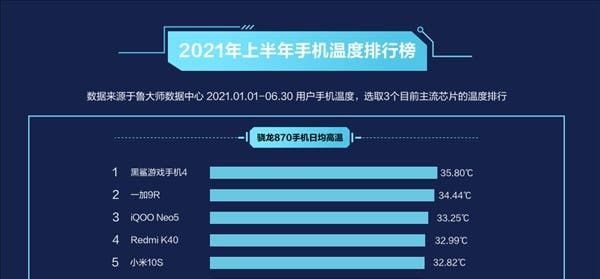A few days ago, we had an article on the top 10 Snapdragon 888 smartphones that tend to overheat. Today, we want to look at the top 5 Snapdragon 870 smartphones that tend to overheat. The Snapdragon 870 SoC is one of the most popular chips in the industry presently. It is a good alternative to the flagship Snapdragon 888. This chip is a low-heat version of the SD888 and this shows in the rating. However, there are some SD870 smartphones whose heating capacity is as high as the SD888 models. The likes of BlackShark Gaming Phone 4 have an average temperature of 35.80℃ while the OnePlus 9R has an average temperature of 34.44℃. These values are quite high. Let us now look at the details of the top 5 Snapdragon 870 smartphones that tend to overheat.

1. BlackShark Gaming Phone 4 - Average temperature is 35.80°C
According to Master Lu overheating ranking, the BlackShark Gaming Phone 4 has an average temperature of 35.80°C. One surprising aspect of this smartphone is that the BlackShark Gaming Phone 4 Pro with Snapdragon 888 has an average temperature of 35.65°C. Obviously, the heat dissipation optimization on the BlackShark Gaming Phone 4 is not high.
Interestingly, the BlackShark Gaming Phone 4 comes with dual liquid cooling units. These cooling units sandwich the internal components and this gives the device a 30% overall increase in heat dissipation. The design is such that there is proper heat removal from the 5G chip, processor, and charging chip. The design of the smartphone ensures that these components have strategic locations so as to avoid excessive heat concentration.
Furthermore, this device also comes with a large surface area direct contact copper heatsink. This effectively increases the transfer of the heat to the liquid cooling system to accelerate heat release. In addition, this smartphone comes with a new smart NTC temperature sensor. The function of this sensor is to detect the heat profile in the sides of the phones (grip zones). The sensor also transfers the heat information to the cooling system to better control the temperature.
2. OnePlus 9R - Average temperature is 34.44°C
Just like the Snapdragon 888 OnePlus 9 Pro, the OnePlus 9R also has a lot of heating complaints. One user took to the OnePlus forum to complain "My new mobile(OnePlus 9R) is having heating Issue while charging and using the camera too. Normal heat I couldn't care but it's clearly knowing that reasonable heat I am noticing it. Can anyone have any idea to overcome this problem?"
Despite the enhanced cooling system with a vapor chamber to dissipate heat better, the OnePlus 9R still shows significant heating. The average temperature of this smartphone is 34.44°C. This temperature is higher than most Snapdragon 888 smartphones. The only devices that have higher average temperatures are Meizu 18, Xiaomi Mi 11 Pro, BlackShark Gaming Phone 4 / Pro.
3. iQOO Neo5 - Average temperature is 33.25°C
From the official launch note, this smartphone comes with a liquid cooling system and 6000 mm² graphite board. According to the company, with this design, the heat dissipation capacity increases to 210% relative to the previous generation.
Generally, most brands use 3,000 mm² large-scale graphite boards. This means that the iQOO neo5 heat dissipation plates are 2 times larger than the general heat sink models in the market. According to reports, this solution is a top-notch liquid cooling solution. It also reduces the heat transfer and the end-user receives little or no heat.
However, Master Lu's rating shows that this smartphone has an average temperature of 33.25°C. Considering that the only Snapdragon 888 model with a lower average heat is the Asus ROG Phone 5 (33.25°C), the heat dissipation capacity of this device is average. The Snapdragon 870 heating is fairly controlled in this device.
4. Redmi K40 - Average temperature is 32.99°C
The Redmi K40 comes with Xiaomi's LiquidCool Technology. This smartphone has a cooling system area (including the evaporation chamber and heat pipe) of 11540 mm². However, despite the Xiaomi LiquidCool Technology, the Redmi K40 heating is still significant. The Snapdragon 870 in the Redmi K40 appears to run hotter than the Snapdragon 888 in the Redmi K40 Pro in practical use.
However, on Master Lu's average temperature rating, the Snapdragon 870 in the Redmi K40 has an average temperature of 32.99°C while the Snapdragon 888 Redmi K40 Pro has an average temperature of 33.87°C. There was a lot of promotion of the Xiaomi LiquidCool Technology. However, a teardown of this device shows that the Redmi K40 comes with a small copper heat pipe, heat shielding, and some thermal pads. This is many miles adrift from the robust cooling system that comes with the Xiaomi Mi 10 Ultra.
5. Xiaomi Mi 10S - Average temperature is 32.82°C
Back in March this year, Xiaomi officially releaed the Xiaomi Mi 10S with the Qualcomm Snapdragon 870 SoC. This smartphone also comes with a 4780 mAh battery that supports 33W wired, 30W wireless, 10W reverse fast charging. However, the Qualcomm Snapdragon 870 SoC comes with its internal heating which needs to be curbed. To ensure that the heating of this chip is significantly reduced, Xiaomi ensured that it used a VC liquid cooling system on this smartphone. A disassembling of this smartphone shows that the VC liquid cooling system comes with a 3000mm² board size. This system seems to be paying off as the Xiaomi Mi 10S has the least average temperature of 32.82°C according to Master Lu.
Conclusion
The conclusions here are basically the same for any ranking of processors that overheats. We are aware that overheating problems can be annoying, especially when you have a flagship smartphone. However, it is important to note that overheating issues can be the result of either hardware or software issues. Thus, the Snapdragon 870 SoC may not be the sole reason for the heating issues on these flagships. We must also emphasize that on a daily usage, most of these smartphone does not come anywhere near the average temperature.
Furthermore, to curb the heating issues, the smartphone manufacturer needs to do a lot of optimizations. They need to do this in conjunction with the chip manufacturer to improve the smartphone performance. The higher the heat of a smartphone, the lower the performance of the device, this is why most flagship smartphones of 2021 need a good heat dissipation system.






Place comments
0 Comments
You are currently seeing only the comments you are notified about, if you want to see all comments from this post, click the button below.
Show all comments